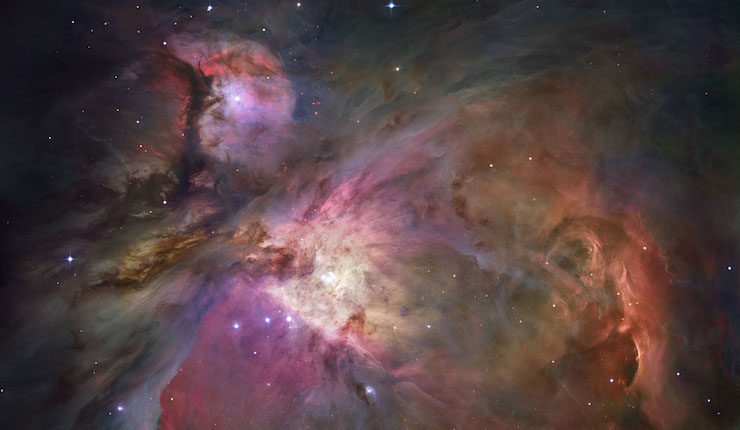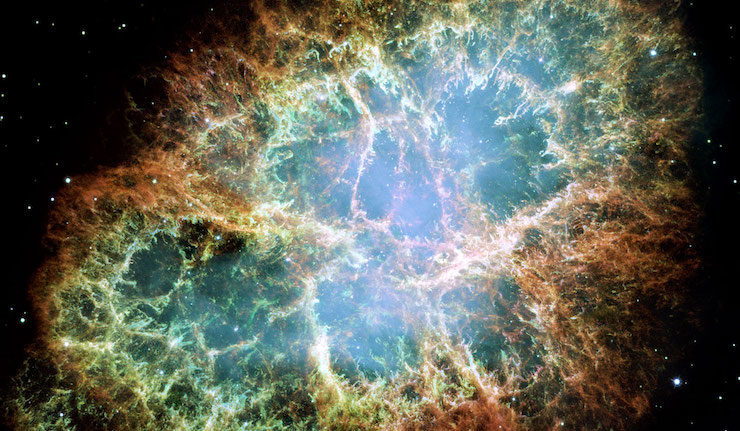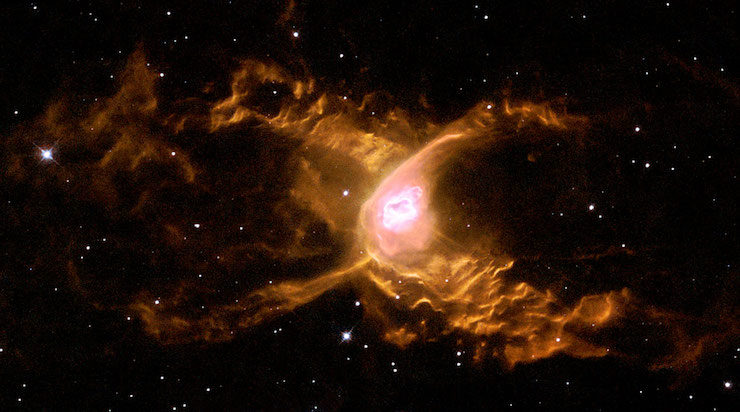Star-wine is very difficult to make. It’s a complex and sometimes dangerous process. But one must have a hobby, and this is mine. Here’s how it’s done.
First, I harvest the stars. People think that you’re only supposed to harvest the ripest stars—the ones that are near to bursting out of their skins, hanging loose off their nebulae—but actually, those stars only make up about half of the crush. I also grab a few unripe ones, the ones that are still cool enough to grab with bare fingers. They warm up when they’re in the basket alongside the fully-ripe stars, but not all the way, and their slight bitterness adds complexity to the press that you can’t get from just aging. To get a really good sense of terroir, I also let a few comets and loose moons drop in with the crush. People won’t tell you to do this, because they want you to think you’re just drinking stars, but honestly… the wine that comes from people who think like that is crap. It’s three-dollar-a-bottle crap and I don’t think you should drink it. That’s my opinion.
Once I’ve got a full harvest, I wash the stars. I usually do this by blowing gently on them. This is a slightly controversial alternative to the newer, more sterile methods favored by the larger galactic wineries, but I find that a little stardust remaining in the press doesn’t hurt anything. Besides, the radiation the stars emit helps to take care of any lingering bacteriological, fungiform, or parasitic infestations. A soft breath is all it takes to dislodge large, unsightly sediment that will cause clogging and flavor issues during the pressing and aging processes. Too harsh of a breath, of course, and the stars cool. This will result in a bitter press if you’re not careful, and is, in my opinion, the reason so much large-press star-wine has sugar added to it between aging and bottling. But then, I’m a traditionalist.

Once the stars are clean, they go into a sterile metal bucket. It doesn’t have to be anything special—you can probably get one at your local hardware store! With wine, as with people, it’s what’s inside the container that counts most.
Next, the pressing. I would say that this is the most important part of making star-wine, but truly, it’s just the hardest part. It’s hard because it’s not complex, and it’s not intricate, and it’s not delicate. You can’t be taught how to press stars well, not by studying and not through an apprenticeship and certainly not by watching. The only way to get the hang of pressing stars is by doing it wrong a thousand times over before you get it right. You have to learn it for yourself. It’s frustrating, but if you’re really dedicated to making good star-wine, you’ll put in the work! It’s worth it.
Most people start by wishing too small. They wish for world peace, or for an end to hunger, and the stars don’t budge. Think about it: If wishes like that could break the skin on a star, they wouldn’t survive to a ripeness suitable for drinking! The stars seem so delicate at peak ripeness that it’s easy for even a veteran harvester to forget that they’ve weathered a lot in their centuries of growth. They’ve heard a lot of wishes—they’ve grown fat and juicy with them—and you’re not going to get them to burst open with a small wish like the first one that popped into your head. The toughest part is that when the stars are still burning, they can still soak in the wishes and sweeten further. If you get it wrong too many times, they’ll start to either cool or rot. I recommend practicing on very small batches while you figure it out.
Everyone has their own methods, but I find that the trick is to wish for something so big as to be impossible. Something you wouldn’t dare to wish for unless you meant to break the stars open. So, an end to hunger and poverty won’t do the job. A wish for peace and goodwill between peoples isn’t going to work either. You’ve got to wish for something that puts a strain on the star and makes it finally, finally split. You’ll have to find the ones that work for you, obviously, but try to think of the things that nothing could ever make happen, and wish for those things. I wish that I could hear him laugh like he did when he was a child, or I wish that I could have fixed things before the end, or I wish that the dark, alone place inside of me could be reached by sunlight. Whatever wish you use, it should be the kind of wish you can only make once. It should leave you feeling husked and hollow and broken.

Once you find the right wish, the skins on the stars will split, and the juice will immediately start running into your press. This is the fun part—my favorite part, really. This is the part where you reach in with both hands and squeeze the cores out of the stars. This part is tiring, and the sensation of the stars bursting between your fingers is reminiscent of reaching into a mouth to pluck out a tongue, or trying to catch a snake as it slides through your garden. There’s no going back once you’ve caught it. There’s no going back once you’ve done it. Now, I always leave a healthy number of skins in with the cores and juice during the fermentation process—like I said, I’m a traditionalist! But if you want a darker batch of star-wine with a less complex flavor, you can strain the skins out. Why you would do something like that, I can’t imagine, but hey, to each their own. The result of your pressing is called the “must.”
Add honey. Some people add sugar, and those people are charlatans who would be better off working at a soda fountain than making star-wine. I use honey from bats that gather pollen from my own nebulae, which is how it’s been done for a long time—but if you don’t tend your own nebulae, or if there’s an eclipse going on at the time of your harvest, or if your bats aren’t producing well, store-bought is fine. I usually add just enough honey to make the must smell like summer, but if you want to make a stronger batch of star-wine, add enough honey to make the must smell like regret.
Don’t worry about yeast. It’s taken care of.
Next, you’ll want to transfer the must into a container to age. This container will impart complexity and depth to the flavor of your star-wine. I like to use oak barrels, but some people prefer pine. Loosely cover the mouth of the barrel with a lightweight cloth woven from the first hairs that fell from your daughter’s head when she was a baby. You might be tempted to use a rubber band or adhesive to hold the cloth in place, but don’t do it! If you’re brewing properly, the cloth will stay put of its own free will. You can always taste when someone has tried to secure the cloth with tools instead of promises—it’s a great way to sour your whole batch, and then you’ll have to start over.

I don’t recommend tasting your star-wine until the first time you cry without knowing why. Some people like to taste sooner, but they end up adjusting the flavor (almost always adding more honey) instead of letting the brew sweeten with time. Be patient! Trust the stars. Ignore the sounds you hear coming from inside the container. Don’t worry if the metal starts to glow and deform—it won’t melt all the way. Do not lift the cloth until it’s time.
You’ll know that your star-wine is ready to bottle when it tastes like power and magnitude and terror. Strain out any particulates, but don’t throw out the muck! I reserve the stuff that I strain out and use it to fertilize my nebulae. The roots really thrive when they’ve got moons to draw nutrients from (plus, the smell of fermented starskins acts as a handy pest repellent). I print my labels at home, because the copy shop has gotten too expensive by half and I might as well use that fancy printer. Microsoft Word has some great templates for printing labels. Make sure to wash your bottles thoroughly and seal the corks tighter than you think you have to; otherwise, when you apply the lead seal to your corks, you’ll get a lot of steam that can crack the glass and is extremely toxic to inhale. You’ll want to let the star-wine mature for at least three years inside the bottle before you drink it, so that it doesn’t turn you into something other than what you are intended to be. Store the bottles in a moonlit place.
It’s a time-consuming and difficult hobby, but once you’ve got the hang of making your own star-wine, you won’t ever want to drink store-bought again! Don’t be scared to give it a try. The worst thing that can happen is that you lose everything you love and everything you are, and what hobby isn’t like that?
 Sarah Gailey’s fiction has appeared in Mothership Zeta and Fireside Fiction; her nonfiction has been published by Mashable and Fantasy Literature Magazine. You can see pictures of her puppy and get updates on her work by clicking here. She tweets @gaileyfrey. Watch for her debut novella, River of Teeth, from Tor.com in May of 2017.
Sarah Gailey’s fiction has appeared in Mothership Zeta and Fireside Fiction; her nonfiction has been published by Mashable and Fantasy Literature Magazine. You can see pictures of her puppy and get updates on her work by clicking here. She tweets @gaileyfrey. Watch for her debut novella, River of Teeth, from Tor.com in May of 2017.









